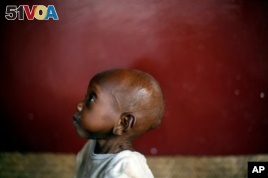March 13,2014
A new report says ending persistent hunger and undernutrition should be top development priorities. The International Food Policy Research Institute, IFPRI, has released its annual Global Food Policy Report.
IFPRI has set a goal of 2025 for ending hunger and undernutrition. The U.N. estimates more than 840-million people still go hungry every day, while over two-billion have a deficiency of essential micronutrients, such as iron, Vitamin A and zinc.

Waka, aged 2, a severely malnourished child sits on the floor at Bangui’s pediatric center in Bangui, Central African Republic, Tuesday, Dec. 17, 2013. According to UNICEF’s doctor Celestin Traore, even though malnutrition is high in the country, the prob
Although very high, those figures actually represent an improvement in recent years. But the progress has not been uniform. The report said there are still major hunger challenges in sub-Saharan Africa and South Asia.
IFPRI Director General Shenggen Fan, said, “We have made tremendous progress in the last several decades. So poverty has come down – undernutrition has come down. However, we’re still facing some tremendous challenges.”
Fan said that solving hunger and undernutrition is a “moral issue.”
“We’ve got to work together to solve that problem. Secondly, it is also [an] economic issue. It makes a lot of economic sense by reducing hunger and malnutrition.”
He said there is a very large return for every dollar invested in reducing hunger. The IFPRI report listed Brazil, China, Thailand and Vietnam as having made dramatic progress -- with policies that emphasize improving agriculture, providing social safety nets and targeting nutrition programs at those most in need.
Fan said it requires cooperation among governments, the private sector, civil society, farmers and others.
“So you have different kinds of approaches that can reduce hunger, malnutrition in a short period of time. Let’s say in 20 years or even 10 years. Why I’m pushing for 2025 is because if we keep the current momentum – the momentum we have created in the last two or three years – put nutrition very high in the development agenda – I believe we can do it by 2025,” he said.
The report said, however, that the “development agenda should not pursue the achievement of environmental sustainability goals at the expense of food and nutritional security and the well-being of poor and hungry people.”
“Why we need a sustainable world is because we wanted to have a sustainable world for people. So it must be people focused. However, if we do not tackle some of the environmental issues, climate change issues, then obviously people will suffer. So, yes, in many areas there may be some trade offs. However, there are many synergies, as well. How can we produce enough nutritious food by using less water, less land, emit less carbon emission? So there are lots of synergies,” said Fan.
New priorities must be set, he said, as the Millennium Development Goals come due. The MDGs – which include reducing hunger – will expire at the end of next year. He said that so far there’s nothing official to replace them, but meetings are underway to do so.
“There are many, many different working groups led by [the] U. N., by high level panels, by civil societies, by many different groups. So, 2014 will be a critical year for different stakeholders to make their contribution to the debate. But finally it is the national governments, who have to own this strategy, who have to own the agenda. So unless they own it, I’m afraid the goals we set will not be achieved.”
The IFPRI director-general said it’s a matter of political will, accountability and adequate resources. He added besides the current focus on staple crops -- maize, rice and wheat – emphasis must be placed on more nutritious foods, such as vegetables and fruits.
He also warned against the current trend in many developing countries of eating more processed foods containing large amounts of fat, sugar and salt. He says this can lead to double dilemma of obesity and undernutrition.